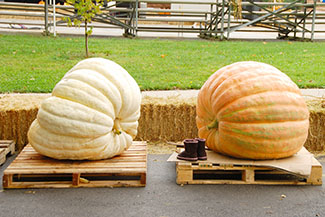Farm Fresh Pumpkins
Oh my gourd! It's Pumpkin Season!
It's October! Pumpkin spice is now everywhere. If you happen to be one of those people that love pumpkin spice flavoring - spice on! If you are not a fan of pumpkin spice and everything nice - it's going to be a long season.
We love pumpkins in general and of course we're celebrating pumpkins in Arizona on so many of our family farms. The 2017 Census of Agriculture, the USDA's most recent, shows 241 acres in Arizona from 114 farms that grew some pumpkins.

Check It Out: Vegetables, Potatoes, and Melons Harvested for Sale: 2017 and 2012
Nationally, Illinois is #1 pumpkin grower with over 17,000 acres, most of the acres (79%) designated as processing pumpkins. It looks like PA is #2 at almost 6,900 total acres of pumpkins and NY is #3 with about 5,900 acres of pumpkins.
Recipes
Jan D'Atri's Peach and Berry Pie
Fun Facts About Pumpkins
- The name pumpkin comes from the Greek word 'pepon,' meaning large melon.
- Colors like red, yellow, and green and a variety of names like Hooligan, Cotton Candy and Orange Smoothie are proof that more than 45 different varieties of pumpkins exist.
- The pumpkin is a member of the Curcubita family which includes squash and cucumbers. These plants are native to Central America and Mexico.
- Pumpkins have been grown in North America for five thousand years. They are indigenous to the western hemisphere
- Eighty percent of the pumpkin supply in the United States is available in October. While they vary in weight, a good-sized pumpkin is typically 10 to 13 pounds.
 And, giant pumpkins can be grown for competitions, with some weighing more than 1,000 pounds. The 2010 world record was 1,810 pounds.
And, giant pumpkins can be grown for competitions, with some weighing more than 1,000 pounds. The 2010 world record was 1,810 pounds.- As a food, pumpkin can be baked, roasted, steamed or boiled. Pumpkin sour and roasted pumpkin seeds have become a favorite of the many food pumpkins can be made into.
- On average, each pumpkin contains approximately 500 seeds, and why we have plenty for roasting and salting from just one of our pumpkin.
- Pumpkins take between 90 to 120 days to grow. High in iron, they can be roasted to eat.
- And on the health kick note, pumpkins contain potassium and Vitamins A and B. Pumpkins are also low in calories, fat and sodium and high in fiber. Additionally, they are a good source of protein. 100 grams of pumpkin produces around 26 calories of energy.
- The flowers that grow on the pumpkin vines are also edible.
- Pumpkins are grown on every continent except Antarctica.
- Morton, Illinois is the self-proclaimed pumpkin capital where you'll find the home of the Libby corporation's pumpkin industry. But it has every right since according to USDA's latest Census of Agriculture identifies Illinois as the number one pumpkin grower with more than 17,000 acres, most designated for processing pumpkins.
- The original jack-o-lanterns were made with turnips and potatoes by the Irish. When they migrated to the United States the brought the tradition with them but as Americans, we discovered a pumpkin was as easy to carve. In England, they used large beets and lit them with embers to ward off evil spirits.
- In early colonial times, pumpkins were used as an ingredient for the crust of pies, not the filling.
- Pumpkins were once recommended for removing freckles and curing snake bites.
- The largest pumpkin ever grown weighed 1,140 pounds.
- The Connecticut field variety is the traditional American pumpkin.
- Pumpkins are 90 percent water.
- Native Americans flattened strips of pumpkins, dried them and made mats.
- Native Americans used pumpkin seeds for food and medicine.
- More than 1.5 billion pounds of pumpkin are produced each year in the United States, and yes, many of them are coming from Illinois. Other top producing states are Indiana, Ohio, Pennsylvania and California.
- In 1584, after French explorer Jacques Cartier explored the St. Lawrence region of North America, he reported finding "gros melons." The name was translated into English as "pompions," which has since evolved into the modern "pumpkin."
- Pumpkin pie is a sweet dessert that originates in North America and is traditionally eaten during harvest time and holidays such as Thanksgiving and Christmas.
- Pumpkins are popular decorations during Halloween. A carved pumpkin illuminated by candles is known as a 'jack-o-lantern'. The tradition is believed to have come from Ireland, where they used to carve faces into turnips, beet and other root vegetables as part of the Gaelic festival of Samhain.
- Native Americans grew and ate pumpkins and their seeds long before the Pilgrims reached this continent. Pilgrims learned how to grow and prepare pumpkins from the Native Americans.
- Pumpkin was most likely served at the first Thanksgiving feast celebrated by the Pilgrims and the Native Americans in 1621.
- The earliest pumpkin pie made in America was quite different than the pumpkin pie we enjoy today. Pilgrims and early settlers made pumpkin pie by hollowing out a pumpkin, filling the shell with milk, honey and spices and baking it.
By Julie Murphree, Arizona Farm Bureau Outreach Director
#FarmFresh #Pumpkins
Podcast
Katie Leister of Rocker 7 Farm Patch join Julie with The Arizona Farm Bureau talking about their pumpkin patch and the other family events in October. Katie explains how they promote traditional Arizona agriculture by educating children and adults through hands-on experience with their real working farm.
Check Out The Rest Of The Broadcast
###
